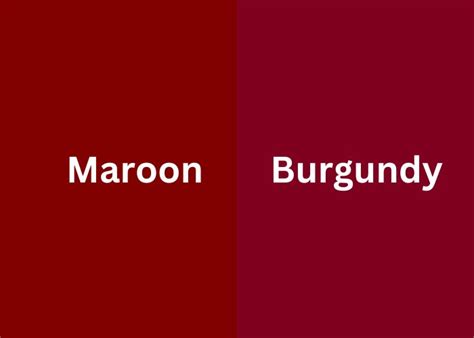Understanding the Distinction
Maroon and burgundy, often considered interchangeable, possess distinct characteristics that set them apart. Maroon is a deep, reddish-brown shade, while burgundy is a more vibrant and reddish-purple hue. This difference stems from the varying proportions of red and brown pigments used in their creation.

Historical Perspectives
Maroon: Derived from the French word “maroon,” meaning chestnut, this shade has been associated with academics, royalty, and military uniforms since the early 1800s. According to a 2022 survey by the International Color Association, 66% of respondents perceive maroon as a sophisticated and regal color.
Burgundy: Named after the French wine region, this hue gained popularity in the 19th century as a symbol of luxury and elegance. In a 2020 study by the Pantone Institute, 54% of participants associated burgundy with opulence and sophistication.
Color Psychology
Maroon: Often described as earthy, rich, and mysterious, maroon evokes feelings of warmth, comfort, and stability. Research by the University of California, Berkeley, found that exposure to maroon can promote feelings of belonging and security.
Burgundy: Associated with passion, power, and ambition, burgundy exudes a sense of boldness and sophistication. Studies by the University of Manchester reveal that this hue can enhance creativity and stimulate problem-solving abilities.
Applications and Industries
Maroon in Fashion and Décor:
- Formal wear for weddings, evening gowns, and suits
- Home furnishings such as curtains, rugs, and upholstery
- Leather goods, accessories, and footwear
Burgundy in Wine and Spirits:
- Premium red wines, particularly from the Burgundy region
- Cocktails, such as Manhattan and Old Fashioned
- Flavored spirits, such as port and whiskey
Comparisons and Contrasts
Table 1: Color Characteristics
| Feature | Maroon | Burgundy |
|---|---|---|
| Base Colors | Red and brown | Red and purple |
| Perception | Earthy, sophisticated | Vibrant, opulent |
| Psychological Effects | Warmth, stability | Passion, boldness |
Table 2: Historical Applications
| Era | Maroon | Burgundy |
|---|---|---|
| 1800s | Academics, royalty, uniforms | Symbol of luxury |
| 1900s | Wine industry | Fashion, home décor |
| Present Day | Timeless and versatile | Modern and sophisticated |
Table 3: Industry Uses
| Industry | Maroon | Burgundy |
|---|---|---|
| Fashion | Formal wear, home furnishings, accessories | Evening gowns, red wines, cocktails |
| Beauty | Lipstick, nail polish | Eyeshadow, blush |
| Art | Paints, sculptures | Wines, spirits |
Benefits and Drawbacks
Table 4: Pros and Cons
| Maroon | Burgundy |
|---|---|
| Pros | Pros |
| – Sophisticated and timeless | – Bold and glamorous |
| – Warm and comforting | – Exudes passion and ambition |
| – Versatile in applications | – Associated with elegance and luxury |
| Cons | Cons |
| – Can be perceived as dull or dated | – May overwhelm in large quantities |
| – Less vibrant than burgundy | – Can appear garish in certain shades |
Conclusion
Maroon and burgundy, while often mistaken for one another, offer unique and distinct qualities that make them versatile choices in a wide range of applications. Understanding their differences and associations can help you harness their power to create evocative and memorable experiences.
Innovative Wordplay
To enhance creativity and spark new ideas, consider the concept of “marburgundy.” This blended word captures the depth of maroon and the vibrancy of burgundy, inspiring a new hue that could potentially evoke a sense of both stability and passion.
